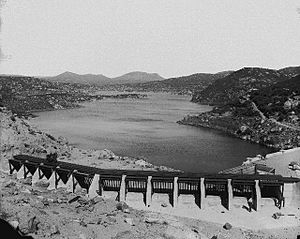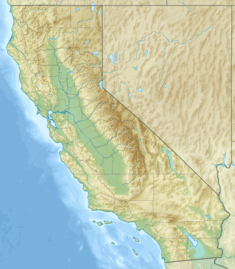Morena Dam facts for kids
Quick facts for kids Morena Dam |
|
|---|---|

View of Morena Reservoir from near the dam, looking upstream, c. 1918
|
|
|
Location of Morena Dam in California
|
|
| Country | United States |
| Location | San Diego County, California |
| Coordinates | 32°41′07″N 116°32′51″W / 32.68528°N 116.54750°W |
| Purpose | Water supply |
| Construction began | 1896 |
| Opening date | 1912 |
| Owner(s) | City of San Diego |
| Dam and spillways | |
| Type of dam | Rockfill |
| Impounds | Cottonwood Creek |
| Height | 177 ft (54 m) |
| Length | 550 ft (170 m) |
| Reservoir | |
| Creates | Morena Reservoir |
| Total capacity | 50,694 acre⋅ft (62,530,000 m3) |
| Catchment area | 114 sq mi (300 km2) |
| Surface area | 1,475 acres (597 ha) |
| Normal elevation | 3,039 ft (926 m) (spillway) |
Morena Dam is a large dam built from earth and rock. It crosses Cottonwood Creek, which flows into the Tijuana River. This dam is located in southern San Diego County, California, in the United States.
The dam was finished in 1912 and has been made taller several times since then. It is one of the oldest parts of the water system for the city of San Diego. Morena Dam helps provide between 1,600 and 15,000 acre-feet of water each year. It is special because it gets all its water from local rainfall and runoff.
How Big is Morena Dam?
Morena Dam is found in the Cleveland National Forest. It sits at the very beginning of Cottonwood Creek, about 40 miles (64 km) east of downtown San Diego.
The dam stands 167 feet (51 m) tall from the riverbed. It is 550 feet (168 m) long. If you measure from its very bottom (the foundations), it is 177 feet (54 m) high. The dam is made of 335,300 cubic yards (256,300 m³) of earth and rock.
When the reservoir is full, it can hold 50,694 acre-feet (62.5 million m³) of water. This water covers an area of 1,475 acres (597 ha). The area that drains water into the dam is 114 square miles (295 km²). This area includes Morena Creek, which is where the dam and reservoir get their name.
Water leaves the reservoir through a 387-foot (118 m) long tunnel. This tunnel gets water from an intake tower. The tower can pull up to 595 cubic feet per second (16.8 m³/s) of water. It can take water from different depths of the reservoir.
The spillway is on the north side of the dam. It is 310 feet (94 m) long and is 3,039 feet (926 m) above sea level. Steel gates, 7.5 feet (2.3 m) high, control floodwaters through the spillway. This spillway can handle about 25,000 cubic feet per second (708 m³/s) of water during floods.
How Morena Dam is Used
Morena Reservoir is mainly used to store water from winter floods in Cottonwood Creek. It is the first of three reservoirs that supply water to San Diego. The other two are Lower Otay and Barrett.
Water released from Morena Dam flows down Cottonwood Creek to Barrett Lake. From Barrett Lake, the water is sent to Lower Otay Reservoir through a 14-mile (23 km) long pipe called the Dulzura Conduit. After Lower Otay, the water goes to the Otay Water Treatment Plant. Then it flows into the city's water pipes. This whole system is called the Cottonwood-Otay Water System.
Morena Dam used to be San Diego's main water source. But after 1939, the city started getting water from the Colorado River. Now, Morena Reservoir is a backup water supply. It is used during dry years because local water is much cheaper than imported water. For example, local water costs about $240 per acre-foot, while Colorado River water costs about $800 per acre-foot. On average, Morena provides only about 3 percent of the city's total water.
Morena Reservoir has a larger surface area than Barrett Lake. This means more water evaporates from Morena. So, the city tries to store water in Barrett Lake whenever possible. Water is often moved from Morena to Barrett if there is space. Also, the area above Morena Dam usually doesn't get enough rain to fill the reservoir completely. On average, only about 10,218 acre-feet (12.6 million m³) of water flow into it each year. This is only about one-fifth of its full capacity. Because of this, Morena Reservoir only fills up to the spillway level about once every ten years.
History of the Dam
The idea for Morena Dam came about in the 1880s. A company called Southern California Mountain Water Company wanted to build a system of reservoirs and pipes. This system would bring water from the Tijuana and Otay river areas to San Diego.
In 1896, money was approved to start building Morena Dam. It was planned to be the highest and most distant of the reservoirs. Construction began in the fall of 1896. Edwin Capps, a San Diego city engineer, was in charge. The first part of the construction had many problems with leaks and poor design. Work stopped in April 1898.
Construction didn't start again until May 1909. This time, engineer Michael O'Shaughnessy led the project. The dam was finally finished in 1912. It cost about $1.5 million.
The city of San Diego bought the dam from Mountain Water Company in 1914. Since then, the dam has been made taller several times to hold more water. It was raised 5 feet (1.5 m) in 1917, 10 feet (3.0 m) in 1923, 4 feet (1.2 m) in 1930, and 2 feet (0.6 m) in 1946. The spillway was also rebuilt and made wider in 1946 to make it safer during floods.
Because the dam was built in a high mountain area, it was expected to fill every year. This area gets some of the most rain in San Diego County. However, the early 1900s had many dry years in Southern California. The reservoir didn't fill to more than one-third of its capacity for the first few years. It wasn't until 1916 that Morena Dam reached its full capacity for the first time.
The "Rainmaker" Story
In 1916, the city of San Diego hired a man named Charles Hatfield. He was known as the "Rainmaker." Hatfield offered to fill Morena Reservoir for $10,000. The city council wasn't sure he could do it, but they hired him. Hatfield started his "rainmaking" work on January 1.
By January 10, heavy rains began to fall all over San Diego County. Morena Reservoir filled up very quickly, rising about two feet (0.6 m) every hour. On January 26, the reservoir was full and water began to flow over the spillway. It was only 5 inches (13 cm) from the very top of the dam.
However, the heavy rains caused severe flooding in the rest of the county. Bridges were washed away, neighborhoods were flooded, and tragically, many people lost their lives. The city then said the rains were an "act of God." They decided that if Hatfield wanted his fee for filling the reservoir, he would also have to pay for all the damage caused by the floods. Charles Hatfield never took the money.


